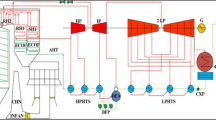Abstract
The formation of nitrogen, sulfur, and carbon oxides in burning fuel oil in boiler furnaces, the elevated water content arising during unloading fuel oil from or its storage in tanks, the formation of deposits in fuel facilities' equipment during its operation, and the high cost of fuel oil are serious obstacles to the use of fuel oil as the main or backup fuel at thermal power stations (TPS). During the long-term storage of fuel oil, water partly settles and distributes in the form of lens, interlayers, or drops that are several to hundreds of micrometers in size. Water cannot be completely removed from the fuel oil by settling since the water and the fuel have nearly the same density. At present, fuel oil covers less than 2% of the fuel balance of TPSs. Considering the fact that there are regions in Russia where fuel oil is the only available fuel for boiler houses, the issues of fuel oil treatment as required for its burning or storage are urgent. Potential possibilities of the existing equipment for preparing fuel oil for burning in the form of fine water-fuel oil emulsions (WFOE) are examined, and the related performance effects are analyzed. The most promising and innovative method to produce WFOEs is the cavitation treatment of immiscible liquids. The equipment designs for cavitation treatment of viscous fluids at boiler houses and TPSs are reviewed. Preference is given to static type cavitation apparatuses featuring high capacity, reliability, and low capital and operating costs.






Similar content being viewed by others
Notes
As a substance whose content is used to set the sanitary-hygienic standard for the maximum allowable concentration (MAC), the most toxic form of vanadium oxide, i.e., vanadium pentoxide (V2O5), has been adopted.
REFERENCES
Yu. G. Nazmeev, Fuel Oil Equipment of Thermal Power Plants (Mosk. Energ. Inst., Moscow, 2002) [in Russian].
Forecast of Global and Russian Power Industry Development up until 2040 (INEI RAN, Moscow, 2014) [in Russian]. http://ac.gov.ru/files/publication/a/2194.pdf
S. R. Sergienko, High Molecular Compounds in Petroleum, 2nd ed. (Khimiya, Moscow, 1964; Israel Program for Scientific Translations, Jerusalem, 1965).
Chemical Encyclopedia, Ed. by I. L. Knunyants (Sovetskaya Entsikl., Moscow, 1988) [in Russian].
V. S. Slepchenok, V. K. Tuchkov, and V. V. Chernikov, “Improving the efficiency of the use of fuel oil equipment of heating boiler rooms,” Nov. Teplosnabzh., No. 3, 8–11 (2004).
N. V. Lavrov, Z. I. Rozenfel’d, and G. P. Khaustovich, Processes of Fuel Combustion and Environmental Protection (Metallurgiya, Moscow, 1981) [in Russian].
E. P. Volkov, V. I. Kormilitsyn, I. G. Zbrailov, and T. A. Tishina, “The influence of operational and design factors on the concentration of nitrogen oxides in the flue gases of steam boilers during combustion of gas and fuel oil,” in Nitrogen Oxides in Combustion Products and Their Transformation in the Atmosphere: Collection of Scientific Papers (Naukova Dumka, Kiev, 1987), pp. 20–27 [in Russian].
V. A. Koryagin, Combustion of Solid Fuel Emulsions and Reduction of Harmful Emissions (Nedra, St. Petersburg, 1995) [in Russian].
I. S. Pearsall, Cavitation (Mills and Boon, London, 1972; Mir, Moscow, 1975).
R. T. Knepp, J. W. Daily, and F. G. Hammitt, Cavitation (McGraw Hill, New York, 1970; Mir, Moscow, 1974).
M. A. Promtov, “Cavitation technology for improving the quality of hydrocarbon fuels,” Khim. Neftegaz. Mashinostr., No. 2, 6–8 (2008).
N. A. Zroichikov, M. G. Lyskov, A. B. Bulgakov, and E. A. Morozova, “Analysis and experience with application of water–fuel oil emulsion at TGMP-314 and TGM-96 power-generating boilers,” Therm. Eng. 53, 444–448 (2006).
M. A. Promtov, Rotary Type Pulsation Devices: Theory and Practice (Mashinostroenie, Moscow, 2001) [in Russian].
R. F. Ganiev, V. I. Kormilitsyn, and L. E. Ukrainskii, Wave Technology for the Preparation of Alternative Fuels and the Efficiency of Their Combustion (Regulyarnaya Khaoticheskaya Din., Moscow, 2008) [in Russian].
V. I. Kormilitsyn and D. N. Astakhov, “A method of processing materials and a device for its implementation,” Patent RF No. 2282492. MPK V30163/00V016 19/00, Byull. Izobret., No. 24 (2003). https://findpatent.ru/ patent/228/2282492.html
N. A. Zroichikov, M. G. Lyskov, V. B. Prokhorov, and E. A. Morozova, “Optimization of the operating conditions of fuel oil combustion in the furnaces of large-capacity boilers,” Therm. Eng. 54, 444–448 (2007).
V. P. Pavlov, S. P. Batuev, and K. V. Shevelev, “Preparation of a water–fuel oil emulsion for combustion in combustion devices,” in Improving the Efficiency of the Use of Gaseous and Liquid Fuels in Furnaces and Boilers: Collection of Scientific Papers (Leningr. Inzh.-Stroit. Inst., Leningrad, 1984), pp. 22–25 [in Russian].
R. V. Tvaradze, V. D. Yusufova, and A. L. Garzanov, “Assessment of the effect and combustion of a water–fuel oil emulsion on fuel consumption and steam generator efficiency,” Izv. Vyssh. Uchebn. Zaved. Energ., No. 9, 10–12 (1984).
V. M. Ivanov and B. V. Kantorovich, Fuel Emulsions and Suspensions (Metallurgizdat, Moscow, 1963) [in Russian].
V. A. Koryagin, K. V. Shevelev, and S. P. Batuev, “Study of the content of harmful substances in the combustion products of water–fuel oil emulsions,” Prom. Energ., No. 4, 21–24 (1988).
V. I. Kormilitsyn, Ecological Aspects of Fuel Combustion in Steam Boilers (Mosk. Energ. Inst., Moscow, 1998), pp. 18–23 [in Russian].
V. M. Ivanov, Fuel Emulsions (Akad. Nauk SSSR, Moscow, 1962) [in Russian].
Author information
Authors and Affiliations
Corresponding authors
Additional information
Translated by T. Krasnoshchekova
Rights and permissions
About this article
Cite this article
Zroychikov, N.A., Kormilitsyn, V.I., Borozdin, V.S. et al. A Review of Technologies for Treatment of Fuel Oil during Storage and Preparation for Burning in Boiler Units’ Furnaces. Therm. Eng. 67, 106–114 (2020). https://doi.org/10.1134/S0040601520020068
Received:
Revised:
Accepted:
Published:
Issue Date:
DOI: https://doi.org/10.1134/S0040601520020068




